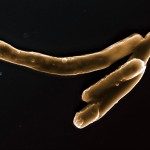Link to Pubmed [PMID] – 12496255
J. Biol. Chem. 2003 Feb;278(8):5513-6
Interactions between dendritic cells (DCs) and Mycobacterium tuberculosis, the etiological agent of tuberculosis, most likely play a key role in anti-mycobacterial immunity. We have recently shown that M. tuberculosis binds to and infects DCs through ligation of the DC-specific intercellular adhesion molecule-3-grabbing nonintegrin (DC-SIGN) and that M. tuberculosis mannose-capped lipoarabinomannan (ManLAM) inhibits binding of the bacilli to the lectin, suggesting that ManLAM might be a key DC-SIGN ligand. In the present study, we investigated the molecular basis of DC-SIGN ligation by LAM. Contrary to what was found for slow growing mycobacteria, such as M. tuberculosis and the vaccine strain Mycobacterium bovis bacillus Calmette-Guérin, our data demonstrate that the fast growing saprophytic species Mycobacterium smegmatis hardly binds to DC-SIGN. Consistent with the former finding, we show that M. smegmatis-derived lipoarabinomannan, which is capped by phosphoinositide residues (PILAM), exhibits a limited ability to inhibit M. tuberculosis binding to DC-SIGN. Moreover, using enzymatically demannosylated and chemically deacylated ManLAM molecules, we demonstrate that both the acyl chains on the ManLAM mannosylphosphatidylinositol anchor and the mannooligosaccharide caps play a critical role in DC-SIGN-ManLAM interaction. Finally, we report that DC-SIGN binds poorly to the PILAM and uncapped AraLAM-containing species Mycobacterium fortuitum and Mycobacterium chelonae, respectively. Interestingly, smooth colony-forming Mycobacterium avium, in which ManLAM is capped with single mannose residues, was also poorly recognized by the lectin. Altogether, our results provide molecular insight into the mechanisms of mycobacteria-DC-SIGN interaction, and suggest that DC-SIGN may act as a pattern recognition receptor and discriminate between Mycobacterium species through selective recognition of the mannose caps on LAM molecules.

